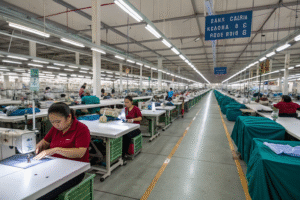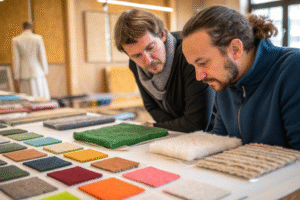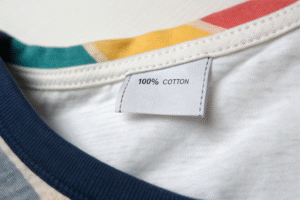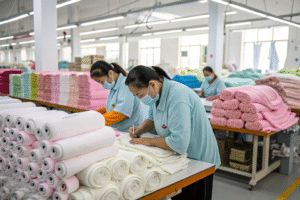In manufacturing, stitch density—the number of stitches per unit length—directly impacts a product’s durability, performance, and aesthetics. Whether producing apparel, upholstery, or technical textiles, the correct stitch density ensures that seams hold under stress, fabrics maintain their shape, and the product looks professionally made.
In short, stitch density is a critical quality control parameter that affects seam strength, comfort, cost, and overall product lifespan.
From optimizing for heavy-duty workwear to ensuring softness in baby garments, adjusting stitch density is part science, part craftsmanship. This article explains why it matters and how manufacturers can get it right.
Stitch density and seam strength in apparel
The primary reason stitch density matters is seam strength. More stitches per inch (SPI) generally mean a stronger seam, up to a point. In apparel manufacturing, an optimal range—often 7–10 SPI for light fabrics and 10–12 SPI for heavier fabrics—prevents seam failure without over-perforating the fabric.
Too low a density and the seam may unravel under minimal stress. Too high, and the fabric can weaken due to excessive needle holes, especially in delicate textiles like silk or fine cotton. For example, heavy-duty denim may require higher SPI to withstand repeated wear, while lightweight toddler clothes need a balanced density to maintain comfort and flexibility.

How does stitch density affect seam strength?
It directly influences seam tensile strength, ensuring the garment can withstand pulling forces.
Can too high stitch density damage fabric?
Yes, excessive density can cause a perforation effect, weakening the fabric structure over time.
Stitch density and fabric compatibility
Different fabrics respond differently to stitch density. Woven fabrics can handle higher SPI for durability, while knits often require a lower density to maintain stretch and avoid puckering. Technical fabrics, like waterproof laminates, may need specialized seam sealing after stitching to prevent leakage.
Manufacturers often test fabric samples using various densities before bulk production, observing for issues like seam slippage, distortion, or fabric tearing. Matching stitch density to fabric type is key to producing a garment that is both functional and aesthetically pleasing.

Why do knits require lower stitch density?
To maintain elasticity and avoid puckering during wear and washing.
How is stitch density chosen for waterproof fabrics?
It’s balanced to maintain seam integrity while allowing for seam sealing to prevent leaks.
Impact of stitch density on aesthetics and cost
Stitch density is not just functional—it also affects how a product looks. Consistent SPI results in smooth, even seams that communicate high quality. Uneven density can cause waviness, puckering, or visible inconsistencies that downgrade the garment’s perceived value.
From a cost perspective, higher stitch density means more thread consumption and longer sewing times, which increases production costs. Manufacturers must balance aesthetics with efficiency, finding the “sweet spot” where the seam is strong and attractive but not unnecessarily expensive to produce.

Does higher stitch density increase manufacturing costs?
Yes. It increases thread usage and machine time, impacting unit cost.
Can uneven stitch density affect brand perception?
Absolutely—customers associate neat, consistent seams with premium quality.
Quality control and testing for stitch density
Maintaining the correct stitch density across production batches requires precise quality control. Inspectors often use SPI measurement tools to verify settings. Seam strength tests, like ASTM D1683, help confirm durability.
In modern factories, digital sewing machines can be programmed to maintain exact densities, reducing human error. For high-risk products—like baby clothing, workwear, or technical gear—random testing ensures that every item meets safety and performance standards.

How is stitch density measured in manufacturing?
By counting stitches per inch or centimeter using transparent rulers or digital tools.
Why is random testing important for stitch density?
It catches inconsistencies before products reach the market, protecting brand reputation.
Conclusion
Stitch density is more than a technical sewing parameter—it’s a critical factor influencing seam strength, fabric compatibility, aesthetics, cost, and quality control. Getting it right ensures products perform well, look professional, and last longer.
For manufacturers, understanding how to optimize stitch density for different fabrics and applications can mean the difference between high returns and high customer satisfaction. At Shanghai Fumao Clothing, we adjust stitch density for each product type—from delicate baby wear to rugged outerwear—ensuring both performance and comfort. Contact our Business Director, Elaine, at elaine@fumaoclothing.com to learn how we can apply precision sewing techniques to your next production run.










